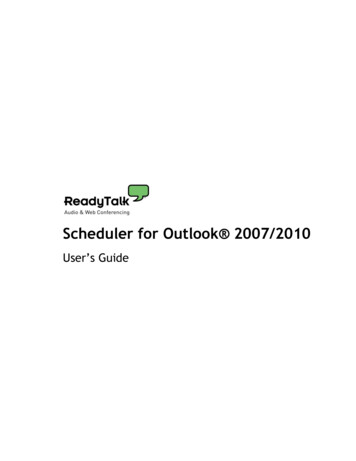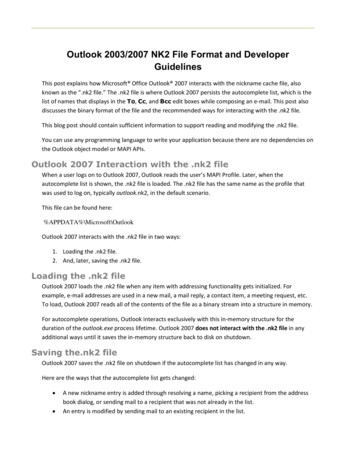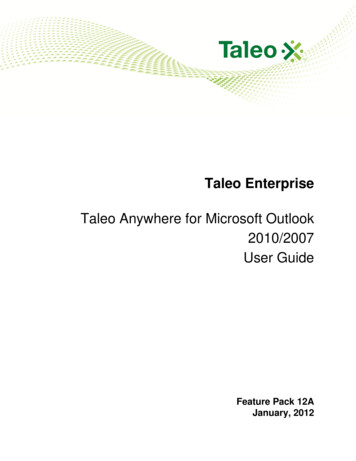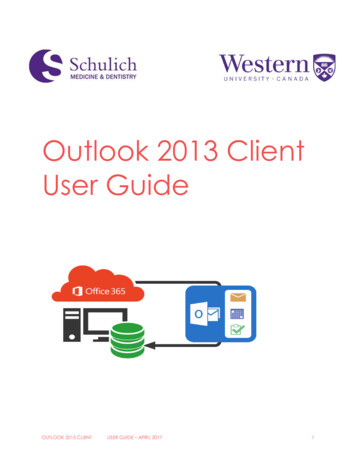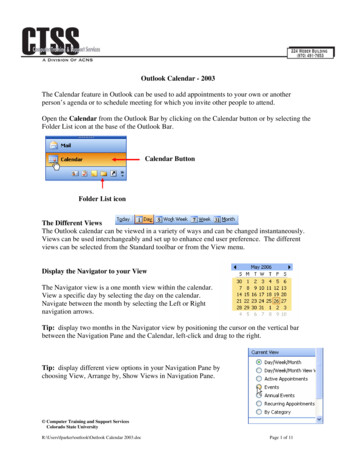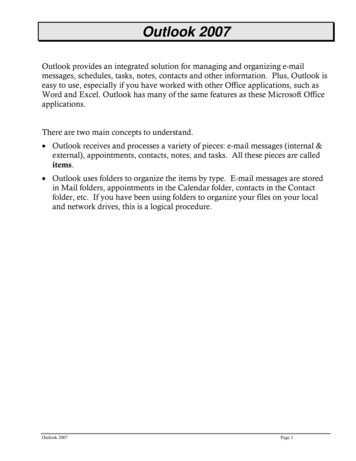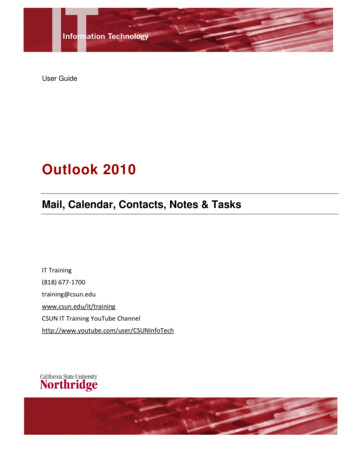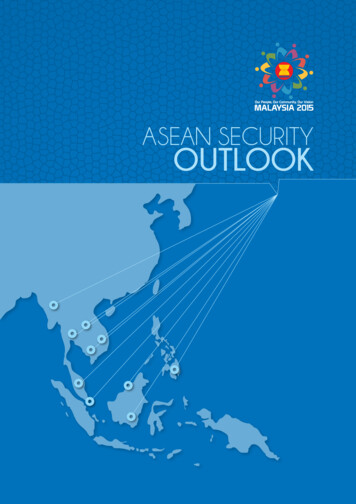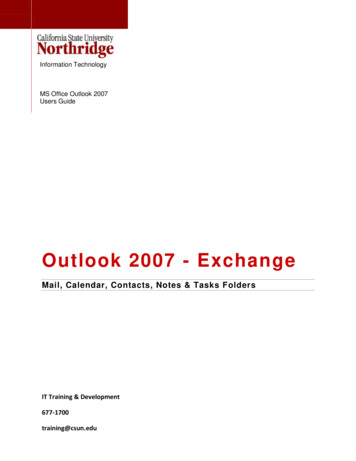
Transcription
Information TechnologyMS Office Outlook 2007Users GuideOutlook 2007 - ExchangeMail, Calendar, Contacts, Notes & Tasks FoldersIT Training & Development677-1700training@csun.edu
Office 2007[OUTLOOK 2007 - EXCHANGE]TABLE OF CONTENTSIntroduction . 1Managing Your Exchange Mailbox . 1Best Practice Using Microsoft Outlook Exchange . 1Determining Mailbox / Folder Size . 2Getting Started . 3Launching Your Outlook Application: . 3Outlook 2007 Window . 4Navigation Pane . 5Outlook 2007 Mail Folder . 6Previewing Mail Messages . 6Opening Mail Messages . 6Creating Signatures. 7Using the Global Address List (GAL) . 9Creating a Mail Message .10Adding Mail Attachments .11Recalling Sent Messages .12Auto Reply Using the Out of Office Assistant.13Personal Outlook Address Book .15Personal Folders in Outlook (.pst) .16Creating a Personal Folder (.pst file) .17Accessing Junk Email Options .20Archiving Mail .21Outlook 2007 Calendar Folder .23Outlook 2007 Calendar Window .23Choosing a Calendar View .24Viewing a Specific Date .24Sizing the Calendar .25Creating New Appointments .25
Creating a New Meeting Request .25Recurring Appointments/Meetings .28Assigning Categories .28Renaming Predefined Categories.30Adding a New Category:.30Deleting a Category.30Outlook Calendar Symbols .31Sharing a Calendar Folder .32Opening a Shared Calendar Folder .33Viewing Shared Calendar Folders .34Modifying a Shared Calendar Folder Permissions - Owners .34Outlook 2007 Contacts Folder .36Creating a New Contact .37Creating Secondary Contacts Folder .38Sharing the Contacts Folder .39Opening a Shared Contacts Folder .41Removing a Shared Contacts Folder Permissions- Owners .42Outlook 2007 Tasks Folder .44Creating a New Task .44Assigning a Task Request .45Accepting or Declining a Task Request .46Sharing a Task Folder .46Opening Shared Tasks Folder .47Modifying a Shared Task Folder Permissions.48Outlook 2007 Notes Folder .50Creating a Note .50Changing a Note's Category.50Sharing the Notes Folder.51Opening Shared Notes Folder .52Modifying a Shared Notes Folder Permissions .53Office Outlook Web Access (OWA) .54Internet Explorer Security .54Logging in to Outlook Web Access (OWA) .55
Using the OWA Mail Folder .56Using OWA Calendar Folder .61Using OWA Contacts Folder .62Using OWA Tasks Folder .62Outlook 2007 Folder Permission Levels .63
Office 2007[OUTLOOK 2007 - EXCHANGE]INTRODUCTIONThis document discusses basic concepts and focuses on using the Mail, Calendar, Contacts,Notes and Task Folders of Outlook 2007 Exchange to organize your workday. This includescreating items within the different folders of Outlook, sharing folders and assigning permissionsfor shared folders.MANAGING YOUR EXCHANGE MAILBOXManaging your mailbox is very important to help maximize campus resources and to ensure thatthe mailbox containing the Mail, Calendars, Contacts, Tasks and Notes Folders, do not exceedthe 500mb quota. The Mail folder should be monitored daily as email, voice mail messages andattachments often use large amounts of space.Best Practice Using Microsoft Outlook Exchange Following best practices will help you:o Organize your mailbox by using a system that is meaningful to youo Move items from your Inbox to your organized folders DAILYo Empty Deleted Items and Junk E-Mail folders DAILYThe items in the Mail, Calendar, Contacts, Tasks and Notes folders contribute to the500mb quota provided with the Exchange Mailbox.Local folders are located on your hard drive and are not available via Outlook WebAccess (OWA) (see Figure 1, below).Figure 1 – Outlook Folder List1
Office 2007[OUTLOOK 2007 - EXCHANGE]Determining Mailbox / Folder Size1. Click Folder List shortcut.2. Click Folder Size 3. The Folder Size display window shows Total Size (including subfolders) andSubfolder breakdown (see Figure 2, below).Figure 2 - Folder Size Display Window2
Office 2007[OUTLOOK 2007 - EXCHANGE]GETTING STARTEDLaunching Your Outlook Application:1. Click the Start button on the Taskbar at the bottom left corner of your Windows screen.2. Click the Microsoft Office Outlook 2007 icon.3. Click on the Mailbox – NAME to display the Mailbox – NAME – Outlook Todaywindow (see Figure 1, below).Figure 1 - Microsoft Outlook – Outlook Today View3
Office 2007[OUTLOOK 2007 - EXCHANGE]Outlook 2007 WindowThe Outlook window for the Mail, Calendar, Contacts, Tasks and Notes Folders are similar inthat they contain the Standard Toolbar, a Navigation Pane, and a Viewing Window. Eachwindow will provide different viewing options specific to the folder. Below is the Mail Folder Inbox display window (see Figure 2, below)Figure 2 – Inbox – Microsoft Outlook1.2.3.4.Menu Bar – Tools for use with Outlook 2007Navigation Pane – Shortcuts to Folder List and Outlook folders.Viewing Pane – Displays the contents of the selected folder.Reading Pane – Displays the contents of the selected item without opening aseparate window.5. Standard Toolbar – Contains shortcuts for Outlook 2007 actions4
Office 2007[OUTLOOK 2007 - EXCHANGE]Navigation PaneThe Navigation Pane, located on the left side of the Outlook window, provides shortcut accessto the folders in your mailbox. Selecting a folder will display its contents in the window above.Currently the Mail folder is selected (see Figure 3, below).Figure 3 – Navigation Pane1.2.3.4.5.6.Mail Folder: where mail is composed, sent, received, and read.Calendar Folder: where appointments and meetings are created and viewed.Contacts Folder: contains contact information not available in the Global Address List.Tasks Folder: where tasks are create, sorted, tracked, and assigned.Notes Folder: where electronic post-able notes are created and viewedFolder List: Displays the folder structure in a hierarchical format; contains Folder Sizelink7. Shortcuts: Area to create and view additional shortcuts.5
Office 2007[OUTLOOK 2007 - EXCHANGE]OUTLOOK 2007 MAIL FOLDERThe Outlook 2007 Mail Folder contains the mail subfolders used to assist the user inorganizing the contents of the Inbox. In addition to the Inbox and the default provision ofsubfolders, users can create additional subfolders to meet their needs. The Deleted Items andthe Junk E-mail folders should be emptied on a daily basis.Previewing Mail Messages1. To preview a message, click on the Inbox folder.2. Turn the Reading Pane on; Select View—Reading Pane—Right / Bottom (seeFigure 1, below).3. Highlight the message to preview.4. Content is displayed in the Reading Pane.Figure 1 – Reading Pane SelectionOpening Mail Messages1. To open a message in a separate window, double click the message.2. To close the message, click the Close icon in the upper-right corner of the messagewindow.6
Office 2007[OUTLOOK 2007 - EXCHANGE]Creating SignaturesYou can create custom signatures for different types of audiences.1. On the Tools menu, click Options, and then click the Mail Format tab.2. Click the Signatures. button (see Figure 2, below).Figure 2 – Options - Signature3. The Signatures and Stationary window displays (see Figure 3, below).4. Click the New button.Figure 3 – Signatures and Stationary7
Office 2007[OUTLOOK 2007 - EXCHANGE]5. In the New Signature window, enter a name for your new signature in the Type aname for this signature: field and click OK (see Figure 4, below).Figure 4 - New Signature6. The new signature name will appear highlighted in the Select signature to edit list(see Figure 5, below).Figure 5 - Select and Edit Signature7. Enter and format your signature information in the Edit signature window (see Figure6, below).Figure 6 - Edit Signature Section8
Office 2007[OUTLOOK 2007 - EXCHANGE]8. In the Choose default signature section, select the appropriate signatures for Newmessages: and Replies/forwards: (see Figure 7, below).9. Click OK.Figure 7 – Choose Default SignatureUsing the Global Address List (GAL)What is the Global Address List (GAL)? The GAL is a list of CSUN Exchange users that is ‘Globally’ accessible by all Exchangeusers. The GAL is listed in the Address Book field (see Figure 8, below).Figure 8 - Address Book – Global Address List The IT department can setup distribution groups (groups of email addresses) bydepartment or project, to improve productivity and communication.9
Office 2007 [OUTLOOK 2007 - EXCHANGE]Restrictions can be placed on distribution groups so only certain users are allowed tosend to it. An example would be a policy by which only executives could send to thedistribution group containing ‘all employees’.If you want to see the members of a distribution group, simply right-click on one of thegroup lists and select ‘Properties’ and the properties window will appear.Creating a Mail Message1. Click the New Mail Message icon; top left hand corner.2. The Untitled – Message (HTML) display window opens (see Figure 9, below).Figure 9 - New – Untitled – Message (HTML) Window3. Click the To, Cc, or the Bcc button to add names from GAL or other contact list.Separate names with a semicolon (;) (see Figure 10, below).Figure 10 - New – Select Names Global Address List10
Office 2007[OUTLOOK 2007 - EXCHANGE]4. Click OK5. In the message body, type the message.6. Click the Send button (see Figure 11).Figure 11 - New – Completed MessageAdding Mail Attachments1. On the Message tab - Include group, click Attach File, to add documents,spreadsheets, etc or Attach Item to add an Outlook item; email, calendar items etc.2. Locate and highlight the file to attach (see Figure 12, below).3. Click the Insert button.4. Complete message and click the Send button.Figure 12 - New Message with Attachment11
Office 2007[OUTLOOK 2007 - EXCHANGE]Recalling Sent MessagesThere may be times where you send a mail message and quickly realize you didn't mean tosend the message, or you noticed an error in the e-mail that needs to be fixed. Exchange2007 has an option to recall messages. However, there are several caveats: The recipient must be an Outlook Exchange user.Message must be unread.Copy of message may be saved on e-mail server.To Recall a Message:1. Select the Sent Items folder (see Figure 13, below).Figure 13 - Highlighted Message in Sent File Folder2. Double-click the e-mail you wish to recall to open it.3. Select Actions - Other Actions - Recall this message (see Figure 14, below).Figure 14 - Sent Message - Recall This Message12
Office 2007[OUTLOOK 2007 - EXCHANGE]4. Choose to either Delete unread copies of this message or Delete unread copiesand replace with a new message.5. Check or uncheck the Tell me if recall succeeds or fails for each recipient box asdesired (see Figure 15, below).Figure 15 – Recall This Message Options6. Click OK.7. If you chose to replace the e-mail, enter in your new message and click Send.Auto Reply Using the Out of Office Assistant1. From the Tools menu, click Out of Office Assistant (see Figure 16, below).Figure 16 – Tools - Out of Office Assistant13
Office 2007[OUTLOOK 2007 - EXCHANGE]2. In the Out of Office Assistant display window, Do not send Out of Office autoreplies is the default setting (see Figure 17, below).Figure 17 - Out of Office Assistant – Default Setting3. Click Send Out of Office auto-replies and the Only send during this time rangebox.4. The Start time: and End time: fields are activated and allow you to set the dates whenyou want auto replies sent (see Figure 18, below).Figure 18 - Out of Office Assistant Activated5. Auto-reply once for each sender with the following messages: allows you tocreate a response for incoming messages received from: (see Figure 19, below). Inside My OrganizationFigure 19 - Inside My Organization - Message14
Office 2007 [OUTLOOK 2007 - EXCHANGE]Outside My Organization (On)On the Outside My Organization (On) tab, select the Auto-reply to people outside myorganization check box, AND select My Contacts only (recommended) (see Figure 20,below).Figure 20 - Outside My Organization (On) MessagePersonal Outlook Address BookThe Global Address List, GAL, is routinely updated based on university information. Users cancreate a personal Outlook address book to save information not available in the GAL.To create a personal address book:1. In the Navigation Pane, right-click Mailbox – your name and, select ‘New Folder’.(see Figure 21, below).Figure 21 – Create a Personal Address Book15
Office 20072.3.4.5.[OUTLOOK 2007 - EXCHANGE]The Create New Folder display window opens (see Figure 22, below).In the Name field, enter a name for the folder.From the Folder contains drop down list, select Contact Items.In the Select where to place the folder box, select where you want the folder to belocated. Selecting Mailbox – YOUR NAME makes the folder available when usingOWA.Figure 22 - Create New Folder6. Click OK7. The new personal address book will be available in the Address Book section(see Figure 23, below).Figure 23 - Address Book – My ContactsPersonal Folders in Outlook (.pst) Personal folders provide many benefits such as:o Allowing you to create back-up copies of your folders on your hard drive.o Enabling you to move items to your hard drive to avoid exceeding your diskquota on the CSUN Exchange server.Choose which type of Personal Folder is right for youo Create a Personal Folder to transfer individual e-mail messages onto your local16
Office 2007o[OUTLOOK 2007 - EXCHANGE]hard drive.Create a Personal Folder to make a copy of your entire email account includingmessages, contacts, and calendar events. Saving individual items into a Personal Foldero Personal folders are stored locally; on your hard driveo Available only when using a specific computero Not available when using OWAoIs no longer part of the Exchange environment; backups are recommended.Creating a Personal Folder (.pst file)1. Click on the File Menu.2. Select Data File Management. (See Figure 24 below)Figure 24 – File - Select Data File Management6. The Account Settings display window appears (see Figure 25, below)7. Under the Data Files tab, click the Add button.Figure 25 – Account Settings Display Window17
Office 2007[OUTLOOK 2007 - EXCHANGE]8. The New Outlook Data File display window appears (see Figure 26, below).9. Select Office Outlook Personal Folders File (.pst) from the Types of storage: list10. Click OK.Figure 26 – Type of .pst file11. The Create or Open Outlook Data File window appears (see Figure 27, below).Figure 27 - File Name .pst file12. Select the location for the folder in the Save in: field.13. Type a descriptive name for your Personal Folders in the Name: field. This name willappear in the Navigation Pane.14. Check the Save as type field reads Personal Folders Files.15. Click OK.18
Office 2007[OUTLOOK 2007 - EXCHANGE]16. The new Personal Folder appears in the Account Settings window (see Figure 28,below).Figure 28 – New .pst Folder17. Click Close.18. The Personal Folders appears in your list of Outlook folders in the Navigation Pane.(see Figure 29, below).Figure 29 - Personal Folders19. To view the contents of the .pst folders, click the Folder List shortcut in the NavigationPane.20. To Move messages, select messages.21. Drag and Drop to new folder.19
Office 2007[OUTLOOK 2007 - EXCHANGE]Accessing Junk Email OptionsThe Junk E-mail Options work in conjunction with other filtering features to prevent deliveryof unwanted mail messages. It uses updated spam lists to evaluate if a message should betreated as junk mail based on the following: By default, the filter is set to Low to catch the most obvious junk e-mail. Any messagethat is caught is moved to the Junk E-mail folder.Filtering is based on the content of the message in general and uses analysis of thestructure of the message to determine the probability that it is junk e-mail.Uses the Safe Senders List so mail from known senders is not treated as junk e-mail.Users in the Contacts Folders are automatically trusted by default; messages frompeople in your Contacts folder will not be considered as junk e-mail.Addresses in the Blocked Senders List blocks specific e-mail addresses or domainnames.Messages from within your organization are not treated as junk e-mail regardless of thecontent of the message.To access additional Junk E-mail Options:1.2.3.4.5.6.From the Tools menu, select Options.Select the Preference tab.Select the Junk Email button (see Figure 30, below).The Junk E-mail Options window displays.Select the additional options for junk e-mail protection.Click OK.Figure 30 – Junk E-mail Options20
Office 2007[OUTLOOK 2007 - EXCHANGE]Archiving MailTo periodically archive your mail requires a .pst folder in a known location. Archiving can bedone one of two ways: Manually moving mail messages from your mailbox to a .PST folder using the drag anddrop method.AutoArchive items on a scheduled basis.a. On the Navigation Pane, click Folder Listb. Right-click the folder you want to AutoArchive, click Properties (see Figure 31,below).Figure 31 – AutoArchive Properties21
Office 2007[OUTLOOK 2007 - EXCHANGE]c. In the ZOther Properties window, click the AutoArchive tab (see Figure 32,below).d. Select either Archive items in this folder using the default settings orArchive this folder using these settings.e. Select the necessary information to complete the archive.f. Click OK.Figure 32 – AutoArchive Properties22
Office 2007[OUTLOOK 2007 - EXCHANGE]OUTLOOK 2007 CALENDAR FOLDEROutlook 2007 Calendar WindowThe Outlook 2007 Calendar Folder provides easy viewing of appointments, meetings andshared calendars. In addition, it provides easy access links to the Date Navigator, the ShareMy Calendars link, the Open a Shared Calendar link and to the Day, Week, Month viewingselections (see Figure 1, below).Figure 1 Outlook 2007 Calendar Window23
Office 2007[OUTLOOK 2007 - EXCHANGE]Choosing a Calendar ViewThere are three different ways to view the calendar, making it easy to find and view youravailability, appointments and meetings. The options are: Day - Shows the events for one (1) particular dayWeek – To select work week or full week, click Tools – Options – Calendar OptionsMonth – Shows the entire monthTo return to the current day, click on Today (see Figure 2, below).Figure 2 - Choosing a Calendar ViewViewing a Specific Date1. To view a specific date, Click on the date in the Date Navigator, located at the upperright of the window (see Figure 3, below).2. To move forward or back from the current month Click on the Left or Right arrowlocated on either side of Date Navigator month.Figure 3 - Date Navigator24
Office 2007[OUTLOOK 2007 - EXCHANGE]Sizing the Calendar1. Point the mouse to the right or left border of the calendar.2. Click and hold the mouse button, move the border as desired.Creating New Appointments1. Click the New icon on the toolbar.2. The Untitled - Appointment display window appears (see Figure 4, below).Figure 4 - Create New Appointment3.4.5.6.Populate the Subject Location, Start/End Time fields.Click the Reminder drop down arrow to select a reminder time.In the Text box type any pertinent information for the appointment.Click Save & Close to record the appointment on the calendar.Creating a New Meeting Request1. Click the down arrow on the New icon and select Meeting Request (see Figure 5,below).Figure 5 - Create New Meeting Request25
Office 2007[OUTLOOK 2007 - EXCHANGE]2. The Untitled—Meeting display window appears (see Figure 6, below).Figure 6 - Untitled - Meeting Request Display Window3. Click the To button to display the Select Attendees and Resources: GlobalAddress List window (see Figure 7).Figure 7 – Global Address List (GAL)4. Using the GAL (Global Address List), select the desired names.5. Click Required or Optional to add people OR click Resources to add a room orequipment.6. Click OK.7. Populate the Subject, Location, and Start and End Time, Reminder and Note fieldsas desired.26
Office 2007[OUTLOOK 2007 - EXCHANGE]8. To verify attendee availability, click on the Scheduling Assistant icon (see Figure 8,below).Figure 8 - Scheduling Assistant Window9. The Scheduling Assistant window displays, showing the availability of attendeesbased on the Show As option entered for each attendee.10. Select a time when all invitees are available, or scroll the Suggested Times: section toview attendee availability.11. Click the Appointment icon to return to the Meeting Request display window.12. Click the Send button.27
Office 2007[OUTLOOK 2007 - EXCHANGE]Recurring Appointments/Meetings1. Click on the Recurrence button on the Options group menu (see Figure 9, below).Figure 9 - Recurrence Button2. In the Appointment Recurrence window, under Recurrence pattern, select theappropriate pattern (see Figure 10, below).Figure 10 - Appointment Recurrence Window3. Under Range of recurrence, select the appropriate range.4. Click OK.Assigning Categories1. Create a new appointment, from the Appointment tab, click the Categorize icon (seeFigure 11, below).Figure 11 - Categorize icon28
Office 2007[OUTLOOK 2007 - EXCHANGE]2. From the Categorize drop down menu, double-click to assign one or more categories(see Figure 12, below).Figure 12 – Categorize Menu3. The item will reflect the number of categories selected (see Figure 13, below).Figure 13 – Item with Two Categories Selected4. To assign categories to existing items, right click the item, click Categorize andhighlight the desired categories from the context menu (see Figure 14, below).Figure 14 - Change Existing Appointment Category29
Office 2007[OUTLOOK 2007 - EXCHANGE]Renaming Predefined Categories1.2.3.4.In Calendar, select an item to activate the Categorize icon.Click the Categorize icon.Click All Categories .In the Color Categories display window, select the Category to rename, clickRename.5. Type the new name6. Click OK (see Figure 15, below).Figure 15 - Color Categories WindowAdding a New Category:1. From the Color Categories display window, select the Category to rename, clickNew.2. Type the Name: field type the name.3. Select a Color/Shortcut Key.4. Click OK (see Figure 16, below).Figure 16 - Add New CategoryDeleting a Category1. From the Color Categories display window, select the Category to delete.2. Click Delete.Note: Deleting a category deletes it only from the Master Category List. Any existing itemswith an assigned category will maintain that category assignment.30
Office 2007[OUTLOOK 2007 - EXCHANGE]Outlook Calendar SymbolsIn the Outlook calendar, symbols represent some of the features associated with meetings orappointments. The following table describes the symbols.SymbolNameDescriptionRecurring itemRepresents an appointment or meeting that recurs on aspecified scheduled.Exception to recurring itemRepresents an item, such as an appointment or meeting,that recurs on a specified schedule; however, this oneinstance is different — or an exception — from the usualpattern of the recurrence.Data conflictA conflict exists between the data on your local computerand the Microsoft Exchange Server. To resolve the conflict,open the item and follow the instructions shown on yourscreen.Start time of an appointment ormeetingMost commonly seen with multi-day items in the Week orMonth views where a specific start and end time have beenset. The time shown in the symbol matches the start time ofthe item.End time of an appointment ormeetingScheduled meetingPrivate itemMost commonly seen with multi-day items in the Week orMonth views where a specific start and end time have beenset. The time shown in the symbol matches the end time ofthe item.A meeting with one or more people is scheduled.If you share your calendar information with other peopleusing Microsoft Exchange or are publishing calendar itemsto a Web site, marking items private prevents details suchas subjects, notes, or location from appearing.ReminderA reminder is associated with Appointment or meeting togive advance notice of a pending event.Meeting WorkplaceA workplace is associated with appointment or meetingFile AttachmentA file attachmen
Office 2007 [OUTLOOK 2007 - EXCHANGE] 3 GETTING STARTED Launching Your Outlook Application: 1. Click the Start button on the Taskbar at the bottom left corner of your Windows screen. 2. Click the Microsoft Office Outlook 2007icon . 3. Click on the Mailbox - NAME to display the Mailbox - NAME - Outlook Today window (see Figure 1, below). Figure 1 - Microsoft Outlook - Outlook Today View
